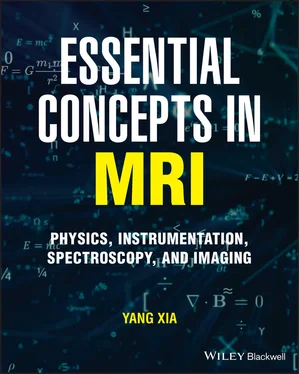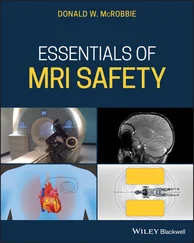Yang Xia - Essential Concepts in MRI
Здесь есть возможность читать онлайн «Yang Xia - Essential Concepts in MRI» — ознакомительный отрывок электронной книги совершенно бесплатно, а после прочтения отрывка купить полную версию. В некоторых случаях можно слушать аудио, скачать через торрент в формате fb2 и присутствует краткое содержание. Жанр: unrecognised, на английском языке. Описание произведения, (предисловие) а так же отзывы посетителей доступны на портале библиотеки ЛибКат.
- Название:Essential Concepts in MRI
- Автор:
- Жанр:
- Год:неизвестен
- ISBN:нет данных
- Рейтинг книги:5 / 5. Голосов: 1
-
Избранное:Добавить в избранное
- Отзывы:
-
Ваша оценка:
- 100
- 1
- 2
- 3
- 4
- 5
Essential Concepts in MRI: краткое содержание, описание и аннотация
Предлагаем к чтению аннотацию, описание, краткое содержание или предисловие (зависит от того, что написал сам автор книги «Essential Concepts in MRI»). Если вы не нашли необходимую информацию о книге — напишите в комментариях, мы постараемся отыскать её.
A concise and complete introductory treatment of NMR and MRI Essential Concepts in MRI
Essential Concepts in MRI
Essential Concepts in MRI — читать онлайн ознакомительный отрывок
Ниже представлен текст книги, разбитый по страницам. Система сохранения места последней прочитанной страницы, позволяет с удобством читать онлайн бесплатно книгу «Essential Concepts in MRI», без необходимости каждый раз заново искать на чём Вы остановились. Поставьте закладку, и сможете в любой момент перейти на страницу, на которой закончили чтение.
Интервал:
Закладка:
178 165
179 166
180 167
181 168
182 169
183 170
184 171
185 172
186 173
187 174
188 175
189 176
190 177
191 178
192 179
193 180
194 181
195 182
196 183
197 184
198 185
199 186
200 187
201 188
202 189
203 190
204 191
205 192
206 193
207 194
208 195
209 196
210 197
211 198
212 199
213 200
214 201
215 202
216 203
217 204
218 205
219 206
220 207
221 208
222 209
223 210
224 211
225 212
226 213
227 214
228 215
229 216
230 217
231 218
232 219
233 220
234 221
235 222
236 223
237 224
238 225
239 226
240 227
241 228
242 229
243 230
244 231
245 232
246 233
247 234
248 235
249 236
250 237
251 238
252 239
253 240
254 241
255 242
256 243
257 244
258 245
259 246
260 247
261 248
262 249
263 250
264 251
265 252
266 253
267 254
268 255
269 256
270 257
271 258
272 259
273 260
274 261
275 262
276 263
277 264
278 265
279 266
280 267
281 268
282 269
283 270
284 271
285 272
286 273
287 274
288 275
289 276
290 277
291 278
292 279
293 280
294 281
295 282
296 283
297 284
298 285
299 286
300 287
301 288
302 289
303 290
304 291
305 292
306 293
307 294
308 295
309 296
310 297
311 298
312 299
313 300
314 301
315 302
316 303
317 304
318 305
319 306
320 307
321 308
322 309
323 310
324 311
325 312
326 313
327 314
328 315
329 316
330 317
331 318
332 319
333 320
334 321
335 322
336 323
337 324
338 325
339 326
340 327
341 328
342 329
343 330
344 331
345 332
346 333
347 334
348 335
349 336
350 337
351 338
352 339
353 340
354 341
355 342
356 343
357 344
358 345
359 346
360 347
361 348
362 349
Preface
In the fall semester of 1994, I became a new assistant professor of physics at Oakland University, in the specialization of medical physics. After receiving my assignment to teach a graduate-level one-semester course in magnetic resonance imaging (MRI) for the next semester, I sat in my nearly empty office and wondered what and how to teach my students. As someone who had been working in MRI research for eight years at that time, I knew the importance of the fundamental theory. As someone who had been a hands-dirty experimentalist, I knew the importance of hardware and software that enabled any experiment. As someone who was specialized in quantitative MRI, I loved this field of research where the final result was an image, hopefully a beautiful and useful one. At the same time, I remembered my occasional regret during my imaging career that I did not know much about spectroscopy. I therefore determined to teach my students a little bit of nuclear magnetic resonance (NMR) spectroscopy.
I started to read the books that were available at the time, to find a potential textbook for my students. I wished I had read some of these books earlier, since there was so much that I simply didn’t know! As I went over these books for a possible adaptation for my course, I could not find any single book that contained what I had in my mind as the four essential and inseparable components of MRI – theory, instrumentation, spectroscopy, and imaging. There were books that were excellent and extensive in each of the four essential components in MRI. I was, however, unable to find one book that introduces all four components that I had in mind. (Asking my students to buy multiple books for one course was not an option.) I eventually realized, painfully, that I would have to put together the materials myself, if I wanted to teach the course as I had planned in my mind. My starting point was two excellent books that were available at that time: P.T. Callaghan’s Principles of Nuclear Magnetic Resonance Microscopy (Oxford University Press, 1991) and R.K. Harris’s Nuclear Magnetic Resonance Spectroscopy (Longman Scientific & Technical, 1989). I had the pleasure to communicate with both authors on their books during my teaching. My lecture notes, evolved and revised substantially during the last 26 years, became the basis for this book.
Since my course is for one 14-week semester, I must pick and choose what I could cover within that given time; I simply do not have time to cover all important concepts in all four components in great detail. I, however, determined to cover all four components of MRI: the theory of physics that explains this fascinating phenomenon, the instrumentation and experimental techniques that facilitate the execution of this fascinating phenomenon, the early adaptation of this physics phenomenon in the practice of NMR spectroscopy, and finally MRI. The requirements and time constraints of the course reflect the compromised (or optimized) choices, which are personal, for the topic selections in this book and the words “ Essential Concepts ” in the title of this book.
This book is grouped into five parts. Part I introduces the essential concepts in magnetic resonance, including the use of the classical description and a brief introduction of the quantum mechanical description. It also includes the description for a number of nuclear interactions that are fundamental to magnetic resonance. Part II covers the essential concepts in experimental magnetic resonance, which are common for both NMR spectroscopy and MRI. Part III describes the essential concepts in NMR spectroscopy, which should also be beneficial for MRI researchers. Part IV introduces the essential concepts in MRI. The final part is concerned with the quantitative and creative nature of MRI research. At the end of the book there are several short appendices, which include some background information on several topics in the book, some sample syllabi for possible ways to teach this course, as well as some homework problems.
I owe a great debt to the late Sir Paul T. Callaghan, who was my graduate advisor at Massey University in Palmerston North, New Zealand during 1986–1992. He taught me the art and science of NMR imaging at microscopy resolution (µMRI).
In my own research journey at Oakland University since 1994, I am very grateful for the beautiful works of my graduate students (Jonathan Moody, Hisham Alhadlaq, Jihyun Lee, Farid Badar, Daniel Mittelstaedt, David Kahn, Syeda Batool, Hannah Mantebea, Amanveer Singh, Austin Tetmeyer, Aaron Blanc), the mutual education of my former postdocs in MRI (ShaoKuan Zheng, Nian Wang, Rohit Mahar, Nagaraja Cholashetthalli), and the stimulating exchange of many visiting and sabbatical scientists to my lab (Paul T. Callaghan, Siegfried Stapf, Hisham A. Alhadlaq, Ekrem Cicek, RanHong Xie, ZhiGuo Zhuang, Zhe Chen). I have also benefited in my MRI research from the collaboration and interactions with many professional colleagues in MRI (Eiichi Fukushima, Kenneth Jeffrey, Gregory Furman, Jia Hua, Yong Lu, Quan Jiang, Jiani Hu, Craig Eccles, Mark Mattingly, Dieter Gross, Thomas Oerther, Volker Lehmann). Thank you.
I am grateful for four five-year R01 grants from the National Institutes of Health (NIH NIAMS) to my research lab at Oakland University, much internal support from the Research Excellence Fund in Biotechnology and the Center for Biomedical Research at Oakland University, the Department of Physics at Oakland University, and an NMR instrument endorsement from R.B. and J.N. Bennett (Oakland University), which initiated and supported my micro-imaging adventure at Oakland University.
Читать дальшеИнтервал:
Закладка:
Похожие книги на «Essential Concepts in MRI»
Представляем Вашему вниманию похожие книги на «Essential Concepts in MRI» списком для выбора. Мы отобрали схожую по названию и смыслу литературу в надежде предоставить читателям больше вариантов отыскать новые, интересные, ещё непрочитанные произведения.
Обсуждение, отзывы о книге «Essential Concepts in MRI» и просто собственные мнения читателей. Оставьте ваши комментарии, напишите, что Вы думаете о произведении, его смысле или главных героях. Укажите что конкретно понравилось, а что нет, и почему Вы так считаете.












